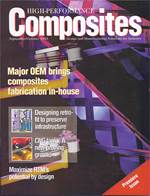HPC’s 20th Anniversary: The senior technical editor looks back
In celebration of HPC's 20th Anniversary, HPC's senior technical editor Sara Black recalls the early days at HPC and the changes that she's seen.
I answered the want ad with some trepidation because I knew nothing about HPC or the publishing company. I had just been laid off at my position writing technical guidance for professionals in the field of environmental geology and hazardous waste remediation, and I really wanted another position as a writer.
At the initial interview, in July 1999, with writing examples in hand, I admitted zero knowledge of composite materials. “Don’t worry, I’ll teach you,” said Judy Hazen, Ray Publishing’s founder, who had worked at Advanced Composites magazine. “It’s just a matter of glue and string,” she announced, very confidently. That was my initiation to the arcane world of composites and the innovative, entrepreneurial people who helped it grow.
Back in those days, working on an early Apple Macintosh and saving files on floppy discs, big applications were always looming mirage-like on the horizon, just out of reach, or in someone’s dusty garage filled with resin formulations. Development projects would be funded, then end abruptly, and all the potential benefits that we touted in our pages would inevitably be ignored due to material costs or fear of risk. Our first wind blade story in 2000 and our analysis of the first downhole composite riser pipe were exciting stuff, but we mourned the demise of the X-33 prototype’s composite hydrogen fuel tank and Adam Aircraft.
But very slowly, the mirages started to materialize, even when economic conditions were dire; when Boeing announced the very composites-intensive 7E7 in 2004, following Airbus’ rollout of the A380 design, it seemed that composites might finally come into their own.
And they have. With Detroit and the European carmakers finally at the table, seemingly ready to incorporate composites into production automobiles, and with the robust growth of aerospace, commercial aircraft, rotorcraft, industrial parts, piping and so much more, I think there are no more mirages; we’re almost across the desert. At the recent Paris Air Show, I found myself walking with a journalist from a well-known defense publication. When I told him about my magazine and why I was there, he cried, with some derision, “Niche, niche niche!” I’m not sure I agree — niche is starting to become necessary.
— Sara Black, Senior Technical Editor
Related Content
-
JEC World 2023 highlights: Recyclable resins, renewable energy solutions, award-winning automotive
CW technical editor Hannah Mason recaps some of the technology on display at JEC World, including natural, bio-based or recyclable materials solutions, innovative automotive and renewable energy components and more.
-
Microwave heating for more sustainable carbon fiber
Skeptics say it won’t work — Osaka-based Microwave Chemical Co. says it already has — and continues to advance its simulation-based technology to slash energy use and emissions in manufacturing.
-
Recycling end-of-life composite parts: New methods, markets
From infrastructure solutions to consumer products, Polish recycler Anmet and Netherlands-based researchers are developing new methods for repurposing wind turbine blades and other composite parts.














